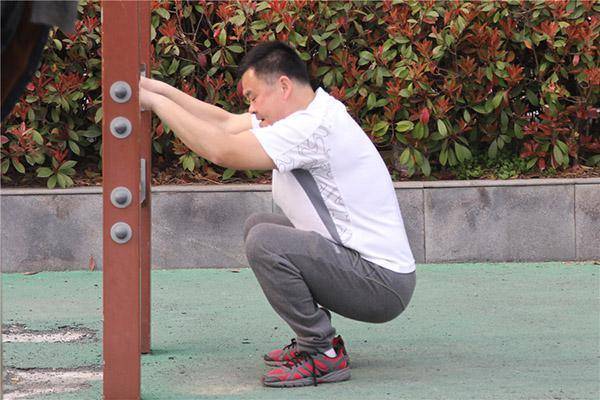In China, there is an ancient saying that goes, “movement leads to health.” Enjoying sports in daily life, exercising more, the body’s absorption efficiency of positive energy is higher, naturally leading to better health. Squats can be described as one of the most routine exercises in sports, yet this simple move is referred to as the “king of strength training.” Especially for male friends who usually sit for long periods without exercising, squat training is particularly suitable.
Some male friends may protest, “Squats are mostly done by girls in the gym for shaping their bodies and weight loss. What benefits can men get from doing this exercise?” You might be surprised, as men benefit just as much as women, if they develop a habit of squatting every day.
Benefit One: Strengthens lower body muscle strength
While many male friends have the habit of exercising and working out, who wouldn’t want to become stronger? However, in the process of exercise, many men focus on training the upper body with exercises like stretching and chest expansion, but neglect lower body workouts.
In fitness terms, it’s like having an “upper body muscle man” and a “leg” for your lower body, which is very unbalanced and not the desired fitness outcome. In the process of squatting, almost all muscles in the lower limbs are engaged in movement and stretching, which provides a good workout for the lower body. This, in turn, leads to improved lower body shape and muscle strength.
Benefit Two: Helps eliminate fatigue
Due to work and life stresses, men often experience physical fatigue and psychological exhaustion, returning home from work each day with no energy to take care of themselves.
However, developing a habit of squatting can effectively help you get rid of this “physically and mentally exhausted” state. On one hand, squats engage multiple leg muscles, promoting internal blood circulation. By enhancing blood flow, fatigue between muscles and limbs can be alleviated.
On the other hand, squatting triggers the brain to release endorphins that create excitement and positive emotions, helping you cope with stress, enjoy and manage your life better. This dual health benefit for the body and mind from squatting is truly advantageous.
Benefit Three: Stimulates testosterone secretion
The growth of muscles not only makes you stronger and healthier but also promotes the secretion of male hormones, such as testosterone.
In other words, the greater the muscle movement during exercise, such as testosterone secretion, the higher the efficiency. The healthier male physiology is maintained. Squatting during exercise engages the most muscle groups throughout the body, using nearly 200 muscles, which enhances muscle workout efficiency, raises testosterone secretion efficiency, and benefits men in various ways.
In conclusion, squatting is not exclusive to women for weight loss and body shaping. Men also benefit greatly from squatting. Many male friends are eager to try it out. However, understanding the details of squatting may be lacking. Doing too few squats may not have the desired exercise effect, while overdoing it can lead to excessive strain on the knees and thighs, causing injuries. So, how many squats should one do daily to adopt a healthy squatting habit?
Actually, there’s no exact number concept, but it varies based on different stages:
For friends who have just started squatting, lacking physical strength and experience, it’s advisable to limit to around 30 squats per day to avoid ligament or meniscus injuries. Don’t be overly ambitious.
For friends who have developed a squatting habit for some time, you can gradually increase the number of exercises to 50 to 80 per day. This is just a reference value.
However, if the number of squats per session is too high, it can put significant strain on the knees and joints. It’s recommended to divide the daily squatting goal into several sets. For example, using 80 squats as a standard, break it down into 4 sets – morning, noon, evening, and before bed, with each set comprising 5 to 10 squats. By spreading the exercise intensity, you can achieve better workout results and reduce knee and joint wear and tear, ensuring both healthy exercise and joint well-being.
Additionally, it’s worth mentioning that to squat effectively for fitness benefits without harming the body, it’s essential to pay attention to the squat posture and avoid common mistakes.
Mistake One: Legs inwardly turned
This is a common mistake during squats, as the soreness in the legs might lead many to subconsciously turn their legs inward to alleviate fatigue. However, this is highly incorrect. Turning the legs inward causes excessive torque on the knees, increasing the risk of lateral twisting injuries.
The correct approach involves keeping the knees apart at a distance greater than the shoulder width to ensure safety while achieving the best workout results.
Mistake Two: Bending the waist during squats
This is a frequently made error during squats due to fatigue or inability to maintain the posture. Some people might bend their waist thinking it’s less strenuous.
But squatting with a bent waist poses risks, as it eliminates the support point during exercise, putting all the strain on the neck. This can lead to neck soreness, shoulder pain, and other negative symptoms after exercise, affecting subsequent activities or rest. To correct this, if you have enough strength, remind yourself to maintain an upright posture during squats to avoid bending the waist unconsciously.
If you find it hard to resist bending the waist during squats, you can opt for assistance tools like the Smith machine or back support, which can also help regulate and enhance the workout effectively.
#MinFukang Health Talks#


